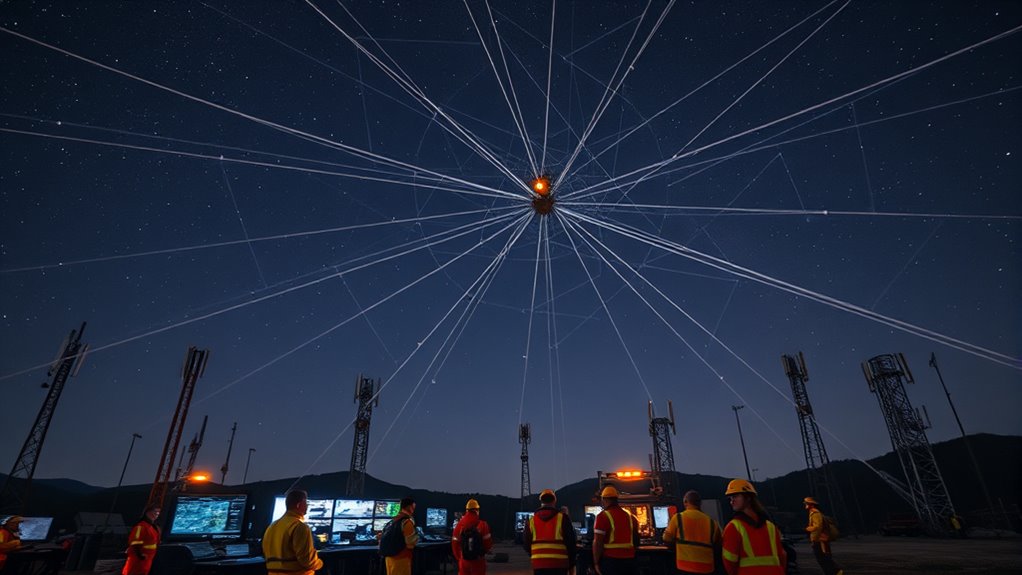Satellite technology plays a pivotal role in disaster communication by providing reliable, wide-area connectivity when traditional networks fail. It guarantees emergency responders stay connected, coordinate efforts, and share essential information quickly. Various systems like geostationary and low Earth orbit satellites offer quick deployment, real-time data, and extensive coverage. Advances in imagery, machine learning, and new satellite designs continue to improve disaster response capabilities. Discover how these innovations can make a difference in crisis management.
Key Takeaways
- Provides reliable communication links when terrestrial networks fail during disasters.
- Ensures connectivity in remote or inaccessible areas for effective response coordination.
- Facilitates real-time disaster monitoring, mapping, and damage assessment through satellite imagery.
- Supports rapid deployment of portable satellite terminals to maintain emergency communications.
- Enhances situational awareness and decision-making with advanced data analysis and early warning systems.
How Satellite Networks Enable Emergency Connectivity

Satellite networks play a essential role in ensuring emergency connectivity when terrestrial communication infrastructure fails or becomes overwhelmed. When disaster strikes, satellite antennae become critical, as they connect ground devices directly to satellites orbiting above. These antennae facilitate reliable signal propagation, even in remote or heavily affected areas. This space-based communication capability is vital for maintaining connectivity in disaster zones. This ability means first responders, governments, and affected populations can stay connected, coordinate rescue efforts, and access important information. The strength of satellite networks lies in their independence from terrestrial systems, ensuring continuous communication during crises. Additionally, the high reliability of satellite links makes them indispensable in disaster response scenarios. By leveraging satellite antennae and the robust propagation of signals through space, satellite networks provide an essential lifeline when traditional networks are compromised. The use of redundant systems further enhances their effectiveness, ensuring that communication remains uninterrupted even if one satellite fails. Moreover, advancements in adaptive routing techniques help optimize signal paths, reducing latency and improving overall communication quality during emergencies. Incorporating digital sound synthesis methods in satellite communication systems can improve the clarity and quality of transmitted audio signals, which is crucial for effective coordination.
Types of Satellite Systems Used in Disaster Response

Different satellite systems serve disaster response in unique ways. Geostationary satellites provide wide coverage, while Low Earth Orbit satellites offer greater flexibility for rapid deployment. Understanding how these technologies work helps you grasp their essential roles in emergency communication efforts. Additionally, the deployment of specialized communication tools such as portable satellite terminals enhances connectivity in remote or disaster-stricken areas. These satellite communication networks are crucial for maintaining coordination and delivering aid efficiently during emergencies. The choice of satellite system depends on disaster response requirements, including speed, coverage area, and terrain considerations. Employing satellite technology effectively can significantly improve response times and the overall success of disaster management strategies.
Geostationary Satellites’ Coverage
Geostationary satellites play a crucial role in disaster response by providing continuous coverage over large geographic areas. Because of their satellite orbit, they stay fixed relative to a point on Earth’s surface, ensuring reliable communication during crises. Their coverage zones encompass entire regions, making them ideal for real-time monitoring and communication. Here’s why they’re essential: 1. They cover extensive areas, reducing blind spots during emergencies. 2. They maintain a constant position, providing uninterrupted connectivity. 3. They support quick deployment of communication services when terrestrial networks fail. Additionally, advances in satellite technology have improved signal strength and data transmission capabilities, further enhancing their effectiveness in disaster scenarios. Reliable communication infrastructure is vital for coordinating relief efforts and saving lives. The development of resilient systems ensures continued operation even under adverse conditions, emphasizing the importance of robust satellite networks. Modern satellite technology also enables faster data relay, which is critical for timely disaster management. Biodiversity conservation efforts highlight the importance of resilient ecosystems, which can be supported through reliable communication infrastructure like geostationary satellites.
Low Earth Orbit Satellites’ Flexibility
Low Earth Orbit (LEO) satellites offer remarkable flexibility in disaster response by providing rapid deployment and adaptable coverage. Their orbital agility allows you to quickly reposition satellites to focus on affected areas, ensuring timely communication when traditional infrastructure fails. Because of their low altitude, LEO satellites can establish high-speed links with minimal latency, making them ideal for real-time data transfer. Their system adaptability means you can scale coverage or upgrade capabilities swiftly, addressing evolving disaster needs. Unlike geostationary satellites, LEO systems can be deployed swiftly and reconfigured as situations change. This agility helps you deliver essential communication services, coordinate rescue efforts, and support affected populations more effectively during emergencies. Additionally, the tuning of satellite systems can enhance their performance and reliability in critical situations, ensuring continuous connectivity in disaster zones. The inherent cost-effectiveness of LEO satellites also makes them a practical choice for ongoing disaster response efforts. Moreover, integrating emergency management strategies with satellite capabilities can further optimize response effectiveness, ensuring comprehensive coverage during crises. Leveraging these systems’ rapid deployment capabilities can significantly improve disaster preparedness and response times, saving lives and resources. Furthermore, the ability to adapt to different environmental conditions ensures these satellites remain operational even under challenging circumstances, maximizing their utility during emergencies. Overall, their flexibility makes them indispensable in dynamic disaster environments.
Satellite Communication Technologies
Have you ever wondered what types of satellite systems are most effective during disaster response? Different systems leverage unique features of orbital mechanics to guarantee reliable communication. Here are three key types:
- Geostationary Satellites: Positioned high above the equator, they stay fixed relative to Earth, providing constant coverage for large areas. They require a satellite launch to reach their orbit and are ideal for continuous communication. Orbital stability ensures their fixed position, making them reliable for long-term disaster management. Additionally, orbital mechanics play a crucial role in maintaining their precise positioning.
- Low Earth Orbit (LEO) Satellites: Orbit closer to Earth, offering lower latency and quick deployment, making them perfect for rapid disaster response. Their orbital mechanics allow for frequent passes over affected regions.
- Medium Earth Orbit (MEO) Satellites: Balancing coverage and latency, MEO satellites are versatile, often used in navigation and communication during emergencies. Their orbital mechanics are more complex but highly effective. Additionally, satellite constellation networks enhance coverage and resilience during disaster scenarios.
Advantages of Satellite Communication During Crises

During crises, satellite communication offers you reliable global coverage, ensuring you stay connected no matter where you are. It also provides consistent connectivity even when power grids fail, which can be vital in emergencies. Plus, its rapid deployment means you can set up communication links quickly when every second counts. Additionally, integration with CRM strategies can help organizations coordinate response efforts more effectively during disaster response. Since satellite signals are less affected by local infrastructure damage, they provide a resilient communication asset critical for effective disaster management.
Global Coverage Assurance
Ever wondered how emergency responders stay connected when terrestrial networks fail? That’s where satellite communication’s global coverage comes in. Because satellites orbit the Earth, they provide connectivity even in remote or disaster-stricken areas. This coverage relies on orbital mechanics, which allows satellites to maintain consistent positions and signals worldwide. Plus, satellite encryption ensures secure communication, preventing interception by malicious parties. Here are three key advantages:
- No geographical limitations, guaranteeing access everywhere.
- Rapid deployment during crises, bypassing damaged infrastructure.
- Consistent coverage thanks to satellites in different orbits.
This combination guarantees that indispensable communication stays uninterrupted, no matter where disaster strikes, giving responders the tools they need to coordinate effectively.
Reliable Connectivity During Power Outages
When power outages hit, satellite communication remains a reliable lifeline because it doesn’t depend on local electrical grids. This is essential for maintaining connectivity in urban infrastructure, where disrupted power can cripple essential services. Unlike traditional networks, satellite links operate independently, ensuring you stay connected even during blackouts. This resilience helps emergency responders coordinate effectively and keeps critical systems online. Additionally, satellite communication enhances internet security by providing a direct, encrypted connection that’s less vulnerable to local disruptions or cyber threats. You can trust satellite networks to deliver consistent, secure communication during crises, safeguarding both operational continuity and public safety. In disaster scenarios, this reliable connectivity becomes a key asset, bridging gaps that terrestrial systems can’t always fill.
Rapid Deployment Capabilities
Satellite communication systems can be deployed rapidly in crisis situations, providing immediate connectivity when time is critical. This quick deployment is possible because satellites can be launched swiftly or repositioned through orbital adjustments, ensuring coverage where it’s needed most. When disaster strikes, you don’t have to wait weeks for infrastructure repairs; satellite systems can be operational within hours or days.
Here are three key advantages:
- Fast satellite launch capabilities enable quick deployment of new satellites to address specific disaster zones.
- Orbital adjustments allow satellites to be repositioned, optimizing coverage and communication links in real-time.
- Satellite systems can be activated remotely, eliminating the need for physical infrastructure setup, saving valuable time during emergencies.
Case Studies: Satellite Technology in Past Disasters

The essential role of satellite technology becomes evident when examining its deployment during past disasters. In events like the 2010 Haiti earthquake, satellite communication provided critical links when ground infrastructure failed. During such crises, satellite signal interference was minimal, ensuring reliable connectivity despite environmental challenges. Satellite orbit optimization was indispensable in maintaining consistent coverage over affected areas, enabling rescue teams and relief organizations to coordinate effectively. For example, during Typhoon Haiyan, satellite systems offered real-time data and communication, saving lives. These case studies highlight how strategic satellite deployment can overcome obstacles, such as signal interference, and optimize orbits for targeted coverage. They demonstrate that satellite technology remains an indispensable tool in disaster response, providing resilient communication channels when terrestrial systems collapse.
Challenges Faced in Deploying Satellite Solutions

Deploying satellite solutions in disaster zones presents several significant challenges that can hinder effective communication. Regulatory hurdles often slow down deployment, as you must steer through complex permissions and international laws. Funding constraints also limit your options, making it difficult to quickly mobilize resources when disaster strikes. Additionally, logistical issues like damaged infrastructure and unpredictable weather can obstruct satellite setup and maintenance. To overcome these obstacles, you need to be prepared for:
- Navigating regulatory approvals swiftly
- Securing flexible funding sources
- Managing logistical and environmental challenges efficiently
These hurdles demand careful planning and coordination, ensuring satellite solutions are deployed promptly and effectively despite obstacles. Recognizing and addressing these challenges is vital for improving disaster communication when it matters most.
Innovations Enhancing Disaster Communication Capabilities

Advancements in satellite technology are transforming disaster communication by providing faster, more reliable links when traditional infrastructure fails. Ground sensors now detect early signs of disasters, transmitting real-time data via satellite to responders, enabling quicker decisions. Weather satellites improve forecasting accuracy, offering critical information before storms or floods strike. Innovations like miniaturized, high-capacity ground sensors can be deployed rapidly in affected areas, enhancing situational awareness. Enhanced satellite imagery from weather satellites allows responders to assess damage instantly, prioritizing aid. These innovations ensure communication lines stay open even in the most challenging conditions. As a result, disaster teams can coordinate more effectively, saving lives and resources. Continuous technological improvements are making disaster communication more resilient, timely, and precise.
Collaboration Between Satellite Providers and Emergency Agencies

Collaborations between satellite providers and emergency agencies are essential for enhancing disaster response efforts. These partnerships streamline communication, ensuring aid reaches affected areas quickly. To work effectively, providers navigate satellite regulation, which sets the rules for spectrum use and data sharing. Building strong provider partnerships involves trust, clear communication, and shared goals. Here are some key aspects:
Collaborations between satellite providers and emergency agencies are vital for efficient disaster response.
- Coordinating satellite regulation compliance to avoid interference and legal issues.
- Establishing rapid response protocols for deploying satellite resources during crises.
- Sharing data securely to improve situational awareness and decision-making.
Future Trends in Satellite Technology for Disaster Management

As satellite technology continues to evolve, it is poised to transform disaster management by providing faster, more reliable communication during crises. Future trends include advanced satellite data collection, enabling real-time updates that improve decision-making. Enhanced disaster mapping capabilities will allow you to visualize affected areas with greater accuracy, facilitating quicker response efforts. Innovations like smallsats and increased satellite constellations will ensure broader coverage and resilience, even in remote regions. Machine learning integrated with satellite data will expedite the analysis of disaster patterns, helping you anticipate events and allocate resources proactively. These advancements will make disaster management more efficient, reducing response times and saving lives. Staying ahead with these trends ensures you can leverage satellite technology for more effective crisis mitigation.
Frequently Asked Questions
How Do Satellite Signals Penetrate Natural Obstructions During Disasters?
During disasters, satellite signals often face natural obstructions like mountains or thick foliage. You’ll find that signal penetration depends on the frequency used; lower frequencies tend to penetrate obstacles better, aiding obstacle mitigation. This allows your satellite communication devices to maintain a connection despite challenging conditions. By leveraging these frequencies, satellite technology guarantees reliable communication, helping you stay connected when traditional systems might fail due to natural obstructions.
What Training Is Required for Emergency Personnel to Operate Satellite Equipment?
Imagine you’re stepping into a scene straight out of “Back to the Future”—you’re required to master satellite calibration and emergency protocols. You need specialized training to operate satellite equipment confidently, understanding how to set up, troubleshoot, and maintain communication links during crises. This guarantees clear, reliable signals, enabling swift response. Your training equips you to handle equipment effectively, ensuring disaster communication remains uninterrupted, even in the most challenging conditions.
How Is Data Security Maintained in Satellite Disaster Communication Systems?
You guarantee data security in satellite disaster communication systems by implementing strong encryption protocols to protect sensitive information. Access controls restrict system usage to authorized personnel, preventing unauthorized access. Regular updates and security audits help identify vulnerabilities, while secure authentication methods verify user identities. These measures create a robust security framework, safeguarding crucial disaster data and maintaining communication integrity during critical situations.
Are There Environmental Concerns Related to Deploying Satellite Infrastructure Post-Disaster?
You should know that deploying satellite infrastructure after disasters raises environmental concerns. For instance, space debris has doubled over the last decade, increasing orbital pollution risks. When launching or replacing satellites, you contribute to this issue, potentially endangering future space activities. While satellite tech aids disaster recovery, it’s essential to balance benefits with environmental impact, minimizing space debris and orbital pollution to preserve space for future generations.
What Funding Models Support Satellite Technology Deployment in Disaster Zones?
You can explore funding models like public-private partnerships and international aid to deploy satellite technology in disaster zones. Public-private partnerships enable collaboration between governments and private companies, sharing costs and expertise. International aid provides vital financial support from global agencies or countries. Combining these sources ensures you secure the necessary funds, facilitating rapid deployment of satellite systems that enhance communication, coordination, and response efforts during disasters.
Conclusion
Just as the phoenix rises from ashes, satellite technology renews hope amid disaster chaos. By bridging gaps when terrestrial networks fail, it acts as a steadfast guardian in your darkest hours. As innovations continue to unfold like stars guiding lost travelers, your safety depends on these celestial lifelines. Embrace this orbital shield, and you’ll find that even in chaos, the sky remains a beacon of resilience and connection.










